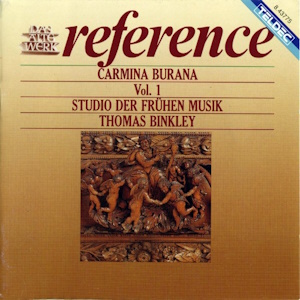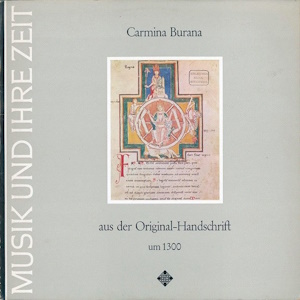 |
| 1 CD -
8.43775 ZS - (c) 1987 |
 |
1 LP -
SAWT 9455-A - (p) 1964
|
|
CARMINA BURANA (I) - 20 Lieder
aus der Originalhandschrift, um 1300
|
|
|
|
|
|
|
|
|
|
| Fas et nefas |
C.B. No. 19 |
Männerstimmen,
Vasentrommel und Schellen
|
|
1' 32" |
1 |
A1
|
| Vris
dulcis in tempore |
C.B. No. 85 |
Tenor und Laute |
|
2' 37" |
2 |
A2
|
| Estivali
sub fervore |
C.B. No. 79 |
Altus
(Countertenor), Flöte und
Vasentrommel |
|
5' 14" |
3 |
A3
|
In
Gedeonis area
|
C.B. No. 37 |
Männerstimmen,
Flöte, Fidel, Laute, Vasentrommel
und Cymbal |
|
4' 28" |
4 |
A4
|
| Dulce
solum
|
C.B. No. 119 |
Altus
(Countertenor) und Langhalslaute |
|
2' 49" |
5 |
A5
|
| Iove
cum Mercurio |
C.B. No. 88a |
Tenor, Rebec,
Cymbal und Vasentrommel |
|
2' 41" |
6 |
A6
|
| Nomen
a solemnibus |
C.B. No. 147a |
Bariton, Flöte,
Fidel und Langhalslaute |
|
3' 40" |
7 |
A7
|
| Sic
mea fata canendo solor |
C.B. No. 116 |
Altus
(Countertenor), Langhalslaute und
Vasentrommel |
|
1' 58" |
8 |
A8 |
| Vite
perdite |
C.B. No. 31 |
Bariton
und Vasentrommel |
|
3' 03" |
9 |
B1 |
| Tempus
transit gelidum |
C.B. No. 153 |
Altus
(Countertenor) und Laute |
|
3' 31" |
10 |
B2 |
| Fulget
dies celebrisend |
C.B. No. 153 |
Knabensopran und
Tenor (Parallelüberlieferung zu
Carmina Burana No. 153 Tempus
transit gelidum)
|
|
1' 07" |
11 |
B3 |
| Exiit
dilucolo |
C.B. No. 90 |
Knabenstimmen,
Flöte und Organetto |
|
1' 21" |
12 |
B4 |
Conspexit
|
C.B. No. 90 |
Knabenstimmen
(Parallelüberlieferung zu Carmina
Burana No. 90 Exiit dilucolo) |
|
0' 34" |
13 |
B5 |
Die
Christi veritas
|
C.B. No. 131 |
Altus
(Countertenor)
|
|
4' 35" |
14 |
B6 |
Procurans
|
C.B. No. 12 |
drei Männerstimmen
|
|
2' 03" |
15 |
B7 |
Planctus
Mariae Virgine
|
- |
(Gottfried von
Breuteuil) - Mezzospran und
Langhalslaute |
|
6' 27" |
16 |
B8 |
Chramer
gip...
|
C.B. No. 107 |
Rebec (Solo)
|
|
0' 30" |
17 |
B9 |
Diu
werlt frovt sih uberal
|
C.B. No. 161 |
Bariton und Fidel
|
|
0' 30" |
18 |
B10 |
Dum
iuventus floruit
|
C.B. No. 30 |
Flöte (Solo) |
|
0' 53" |
19 |
B11 |
Sage,
daz ih dirs
|
C.B. No. 147a |
Mezzospran,
Bariton, Flöte und Fidel
|
|
0' 58" |
20 |
B12 |
Chramer
gip diu varwe mier
|
C.B. No. 107 |
Mezzospran und
Pommer |
|
0' 59" |
21 |
B13 |
|
|
|
|
|
| STUDIO
DER FRÜHEN MUSIK |
Quellen:
|
-
Andrea von Ramm, Mezzosopran
|
-
Barcelone, Arxim Cor. Aragó Ripoll
116 |
-
Willard Cobb, Tenor
|
-
Cambridge, University Library Ff I
17 |
-
Sterling Jones, Fidel und
Rebec
|
-
Chartres, Bibl. munc. 223
(verschollen: durch Film) |
| -
Thomas Binkley, Laute und
Pommer |
-
Escorial Z II 2
|
| Weitere
Mitwirkende: |
-
Evreux, Bibl. munc. 39
|
| -
Grayston Burgess, Countertenor |
-
Florenz, Bibl. Laurenziana pluteus
29. 1 |
| -
Karlheinz Klein, Kurt Rith,
Bariton |
-
Klagenfurt, Stud. Bibl. Perg. Hs. 7
|
-
Lore Wehrung, Flöte
(Querflöte)
|
-
Las Huelgas
|
| -
Horst Huber, Schlagzeug |
-
Linz, Studienbibl. C c III 9 |
| Münchener
Marienknaben / Kurt Rith, Einstudierung |
-
London, Brit. Museum Egerton 2615
|
| Thomas
BINKLEY, Übertragungen und
Bearbeitungen |
-
München 4660 (Carmina Burana) |
|
-
München 4660a (Fragmenta Burana) |
|
-
München 5539 |
|
-
Oxford Bodl. Add. A 44 |
|
-
Paris Latin 3719 |
|
-
Paris Latin 3549 |
|
-
Wolfenbüttel 677 (W 1) |
|
-
Wolfenbüttel 1206 (W 2) |
|
|
|
|
Luogo
e data di registrazione |
|
AEG-Atudio,
München (Deutschland) - 21-25 Juli
1964
|
|
|
Registrazione:
live / studio |
|
studio |
|
|
Producer |
|
Wolf
Erichson
|
|
|
Prima Edizione
LP |
|
Telefunken
- SAWT 9455-A - (1 LP) - durata
53' 17" - (p) 1964 - Analogico
|
|
|
Edizione
"Reference" CD
|
|
Tedec
- 8.43775 ZS - (1 CD) - LC 3706 -
durata 53' 17" - (c) 1987 - AAD |
|
|
Cover |
|
"Musizierende
Kinder", Porzellan. Modell von M.
V. Acier, Meißen, um 1770. Museum
für Kunst und Gewerbe, Hamburg.
|
|
|
|
|
Among the
most valuable treasures
of the Bavarian State
Library in Munich is
Codex latinus monacensis
4660, comprising the
most comprehensive and
most important
collection of secular
Latin lyrics of the
Middle Ages (often
erroneously generalized
under the expression
"Goliardic song"), the Carmina
Burana.
Before being moved to
the Royal Court and
Central Library during
the secularisation of
Bavarian Monasteries in
1803, the manuscript was
kept in the
Benediktbeuren
Monastery; hence this
collection of poetry was
named by its first
editor, the librarian
Johannes Andreas
Schmeller, "Songs from
Benediktbeuren".
When the manuscript was
written, after the
moddle of the 13th
century, somewhere in
South Germany (or
Tyrol?), the flowering
of secular Latin poetry
was already over. Thus
the collection is not a
textbook of a Goliard
but an anthology written
on the order probably of
a clerical aristocrat
who enjoyed this poetry.
The manuscript can be
compared in kind to the
large collections of
middle-high German
poetry such as the
Manesse manuscript.
The manuscript brings
together over 200 pieces
of differing content and
character. The order of
the pieces (disrupted
through binding) was
carefully planned
according to four main
groups: moral and
satirical songs
(observations and
laments on the course of
the world or the
lowering of morals, love
songs, drinking songs,
game songs and real
Goliardie poetry (no
neumes preserved), and
sacred plays. poems of
subjective sensitivity
are found sext to poems
of didactic or learned
character. The greatest
portion sterms from the
late 11th and the 12th
centuries; the majority
of the poetry originated
in France. a few German
poems are mixed in with
the Latin ones. As was
the custom in such
anthologies, the poets
were not named, almost
without exceptions;
however many poems are
lnown through other
soucers, and we can thus
recognize the work of
few known poets as
Walther de Chatillon,
Petrous de Blois, the
archipoeta, etc., while
other poems can be
arranged in groups. The
concordant sources of
single poems are
particularly important
for the reconstruction
of the original texts;
in codex Buranus the
texts are often corrupt.
It seems that the
inclusion of neumes had
been planned for much of
the manuscripts, but
this was carried out for
only a small part, and
there only afterwards
and rather incompletely.
F.
Brunhölzl
The transcription of the
music contained in the
manuscript Carmina
Burana has long been
thought to be an
unsolvable problem.
because the staffless
neum notation does not
represent exact pitch
levels but onlz
indicates the curve of
the melodz. This problem
has been solved here
with reasonable accuracz
bz cross-checking the
neums against versions
of the same pieces
contained in manuscripts
accuracy by
cross-checking the neums
against versions of the
same pieces contained in
manuscripts in square
notation. in which exact
pitch levels are
indicated. The
concordant manuscripts
are those of the Paris
school of the 13th
century.
The cover picture is
taken from folio 1r of
the manuscript and
contains the opening
piece, Fas et nefas
ambulant. The
neums employed are
typical St. Gall forms
of the virga, punctum,
podatus and franculus.
Comparison of this
notation with the same
piece in the manuscript
Florence Plut. 29. 1.
fol. 225 reveals an
unusual use of the virga
for descending motion
(also encountered
elsewhere in Carmina
Burana).
Othe manuscripts provide
polyphonic versions of
many monophonic pieces
in Carmina Burana, such
as Exit in diluculo
and its final stroph, Conspexit,
as well as Fulgat
dies which ist the
polyphonic equivalent of
Tempus transit
gelidum. Musical
settings are provided in
other manuscripts for
some poems without music
in Carmina Burana, such
as Procurans.
The accompanyments
reveal the extensive
influence exerted on
medieval European
musical performance by
arab culture. This
influence came through
early contact with
Persian scholars,
through the Crusades and
through the Moors in
Spain, and was
particularly apparent in
the adoption of exotic
instruments. Many of
these such as the lute
and rebec remained in
use in the Occident for
centuries, while others
such as the long-necked
lute (Balowa) and the
hour-glass drum
(Darabukka) passed out
of use in the fourteenth
century.
The style of performance
on these instruments is
the result of serious
study of their use today
in the countries of
their origin from Persia
to Morocco. Thus,
through reliable
transcription and
careful instrumentation
it is possible to bring
the performance of this
music close to the
elusive original, an
accomplishment thought
impossible just a decade
ago.
Thomas
Binkley
|
|